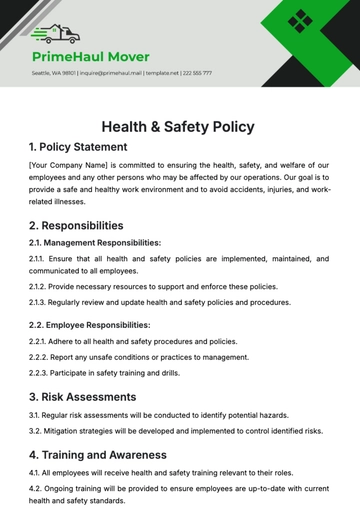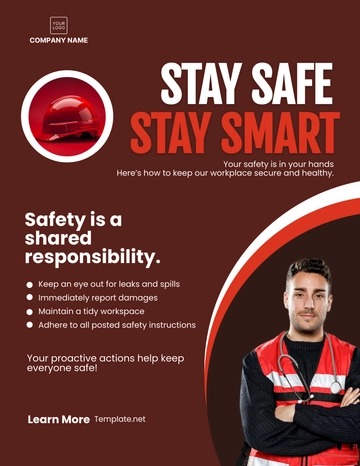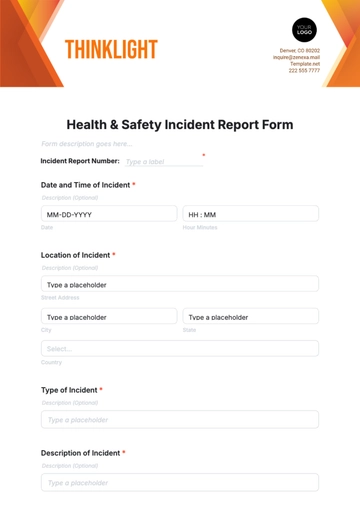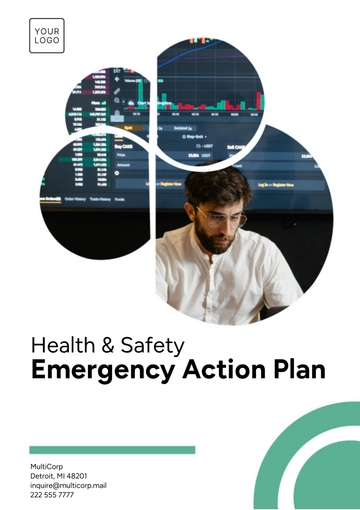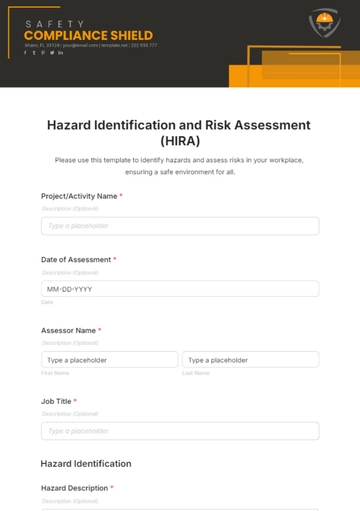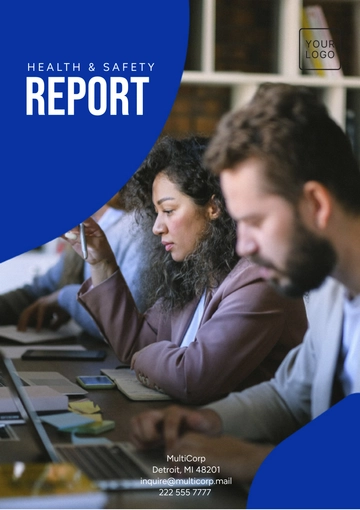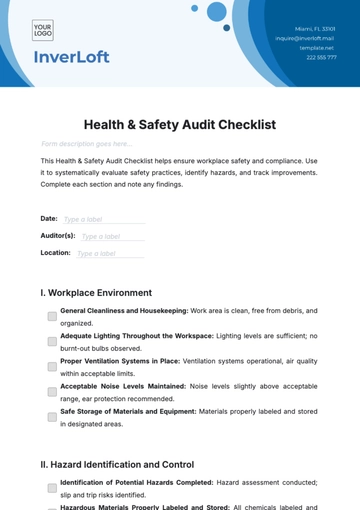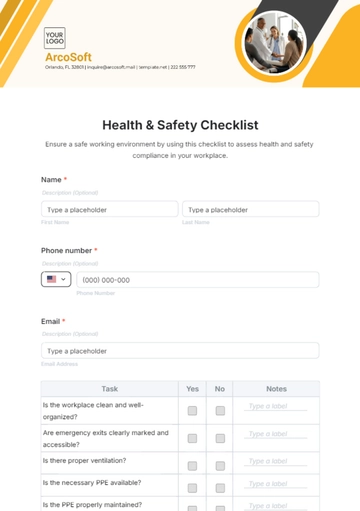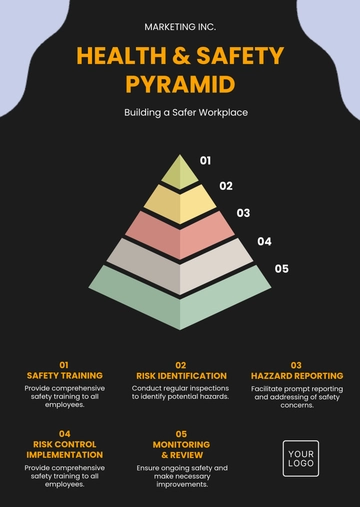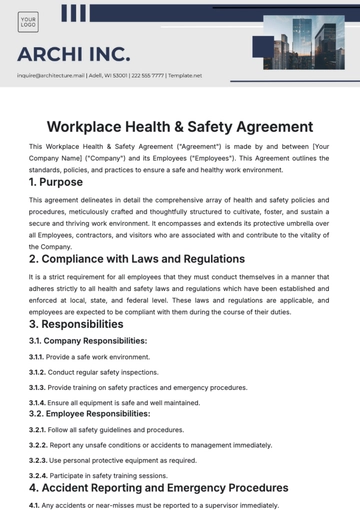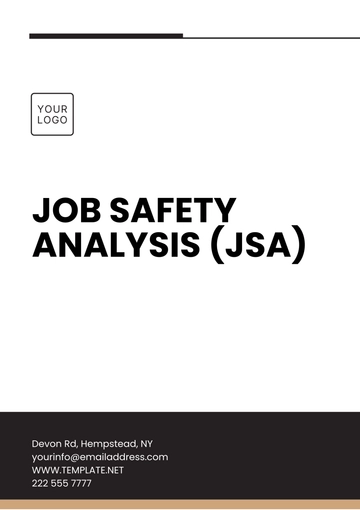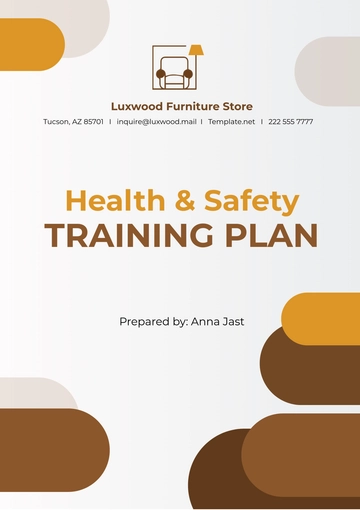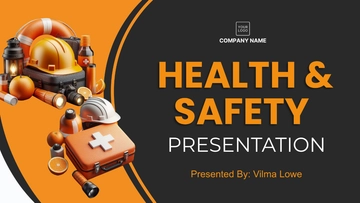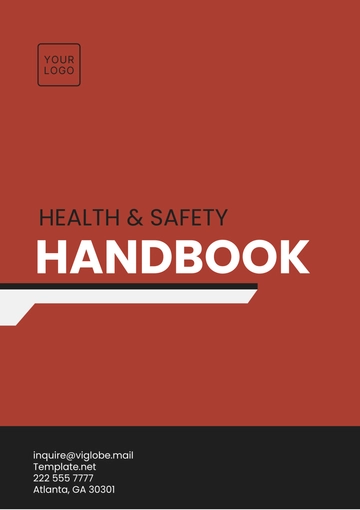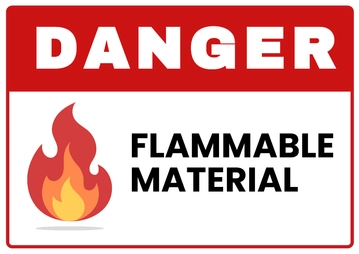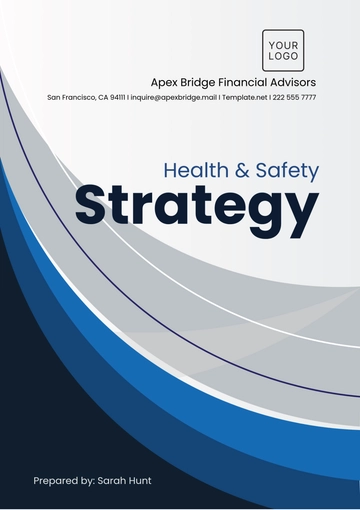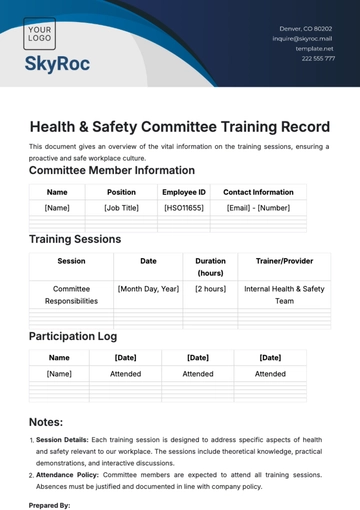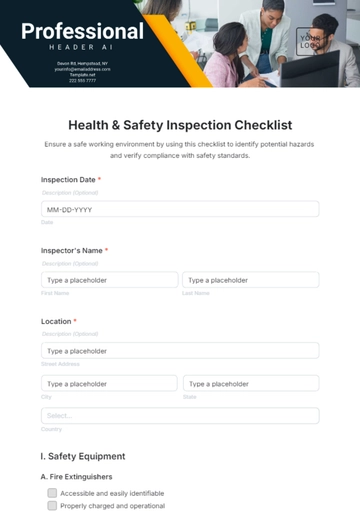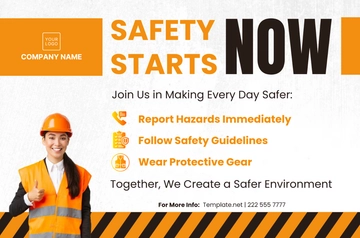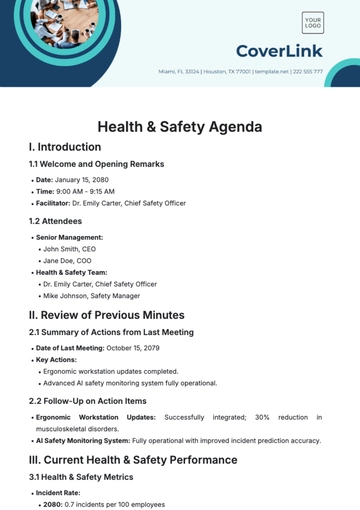Free Health & Safety Committee Legal Compliance Document
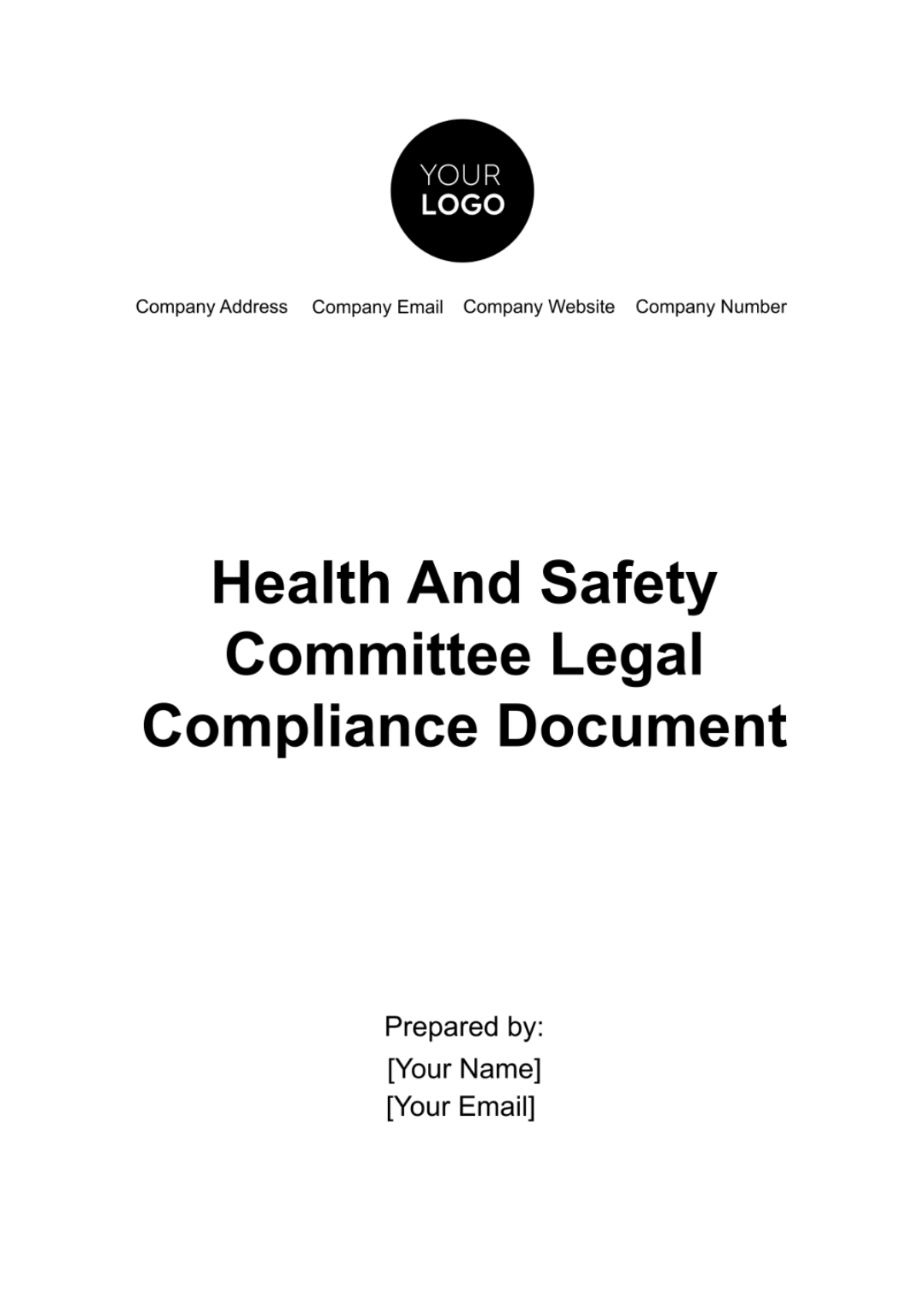
Introduction |
Purpose
This Legal Compliance Document is designed to serve as a comprehensive guide for our Health & Safety Committee, detailing the necessary legal and regulatory standards related to workplace health and safety. Its purpose is to ensure that we are fully informed about and compliant with all relevant laws, thus safeguarding our organization against legal risks and enhancing the overall safety of our workplace.
Importance
Legal compliance in the realm of health and safety is not just a regulatory requirement; it is a fundamental aspect of responsible business practice. Adhering to legal standards helps protect our employees from workplace hazards, reduces the risk of legal penalties, and promotes a culture of safety. Compliance also reflects our commitment to ethical practices and maintaining a reputation as a responsible employer.
Scope
This document encompasses a detailed overview of applicable health and safety laws and regulations, procedures for ensuring compliance, and the roles and responsibilities of the Health & Safety Committee in this context. It covers both national and local regulatory requirements and guides training, reporting, and monitoring procedures to ensure ongoing compliance. The scope is designed to be comprehensive, providing a framework for legal adherence across all aspects of our health and safety practices.
Roles and Responsibilities
Compliance Oversight: Develop and maintain health and safety policies in line with legal requirements; Stay abreast of changes in health and safety laws and ensure organizational practices are updated accordingly.
Monitoring and Reporting: Regularly monitor workplace practices and conditions to ensure compliance with health and safety laws; Maintain comprehensive records of compliance efforts and incidents, and report compliance status to regulatory bodies as required.
Collaboration: Serve as the primary point of contact for OSHA and other regulatory bodies; Work with legal experts to interpret complex regulations and implement compliant practices.
Health and Safety Legislation Overview |
In the United States, workplace health and safety regulations are primarily governed by the Occupational Safety and Health Administration (OSHA). Key laws and regulations include:
Occupational Safety and Health Act (OSH Act): The foundational federal law establishing workplace health and safety standards across various industries.
General Duty Clause: A provision of the OSH Act requiring employers to provide a workplace free from recognized hazards that are causing or likely to cause death or serious physical harm.
OSHA Standards: Specific rules for different sectors, covering a wide range of safety issues, from machinery operation to hazardous material handling.
Recordkeeping Requirements: Mandates for maintaining records of work-related injuries, illnesses, and exposure to hazardous materials.
Whistleblower Protections: Safeguards for employees who report violations of safety standards.
These laws and regulations set the minimum standards for workplace safety and health practices and are enforced by OSHA at the federal level. Additionally, some states have their own OSHA-approved workplace safety and health programs that may have more stringent requirements.
Policy Updates
Recent legislative changes in the US concerning health and safety have focused on enhancing protections in response to evolving workplace challenges. Notable updates include:
Increased Penalties for Violations: OSHA has updated its penalty structure, increasing fines for non-compliance with safety standards.
COVID-19 Workplace Safety Guidelines: Introduction of guidelines and emergency temporary standards for protection against COVID-19 in the workplace, including requirements for social distancing, masks, and sanitization.
Expansion of Recordkeeping Rules: Enhanced requirements for the electronic submission of injury and illness data to improve data collection and enforcement efforts.
Focus on Mental Health: Greater emphasis on mental health in the workplace, including stress management and support for work-related mental health issues.
Compliance Procedure and Protocols |
This section of the document outlines the structured procedures and protocols we have in place to ensure steadfast compliance with health and safety laws and regulations. These procedures are critical in maintaining the integrity and safety of our workplace.
Procedures
Conduct regular audits to evaluate adherence to health and safety regulations.
Implement ongoing training programs for employees to educate them about compliance requirements and safe work practices.
Utilize checklists for various operations and departments to ensure all compliance aspects are covered.
Have clear protocols for responding to safety incidents, including immediate actions, investigation, and reporting.
Regular Review
Schedule annual reviews of all health and safety policies to incorporate any regulatory changes or organizational developments.
Involve various stakeholders, including employees, management, and legal advisors, in the review process to gain diverse insights.
Revise policies as needed based on review findings, regulatory updates, and feedback from employees and safety audits.
Documentation
Maintain accurate and comprehensive records of all health and safety activities, including training sessions, audits, incident reports, and compliance checks.
Ensure that records are easily accessible for review by management, the Health & Safety Committee, and regulatory bodies.
Adhere to a defined retention policy for all health and safety documents in line with legal requirements and best practices.
Implement measures to protect the confidentiality and security of sensitive health and safety records.
Training and Awareness Programs |
This section outlines our commitment to educating our workforce on legal compliance in health and safety. Through these programs, we aim to foster a culture of awareness and proactive compliance among all employees.
Employee Training
Training Program | Target Audience | Frequency | Objective |
OSHA Compliance Training | All Employees | Annually | Educate employees on OSHA standards and compliance procedures. |
Risk Management and Legal Requirements | Managers and Supervisors | Bi-Annually | Train on identifying, assessing, and managing legal risks in operations. |
Record-Keeping and Reporting Procedures | Administrative Staff | Quarterly | Instruction on proper documentation and reporting for compliance. |
Awareness Campaigns
Distribute bulletins and updates on legal changes and compliance tips.
Hold regular awareness sessions/workshops to reinforce the importance of compliance.
Implement feedback channels to gauge employee understanding and gather suggestions for improvement.
Auditing and Monitoring Compliance |
In this section, we detail the systematic approach taken to regularly audit and monitor our adherence to health and safety laws.
Internal Compliance Audits
Health and Safety Compliance | Quarterly |
OSHA Compliance | Bi-Annually |
Environmental Compliance | Annually |
Audit Teams
Health and Safety | Health and Safety Regulations |
OSHA Compliance | Occupational Safety and Health Laws |
Environmental | Environmental Regulations |
Methods and Frequency
Conduct regular inspections of the workplace, including machinery, equipment, and work processes, on a weekly basis.
Perform safety audits bi-annually to assess adherence to safety protocols and standards.
Continuously review documentation related to health and safety, including incident reports, safety data sheets, and training records.
Utilize real-time reporting tools to monitor compliance issues as they arise, ensuring immediate corrective action.
Non-Compliance
Addressing non-compliance is a critical component of our commitment to legal adherence and workplace safety. The following steps outline how corrective actions are performed when non-compliance is identified:
Identification: When non-compliance is identified through audits or monitoring, it is documented immediately.
Root Cause Analysis: A thorough analysis is conducted to identify the root causes of non-compliance. This includes reviewing policies, procedures, and employee actions.
Immediate Response: Immediate corrective actions are taken to rectify the non-compliance issue and prevent further violations. This may involve halting specific operations, isolating hazards, or removing non-compliant equipment from service.
Documentation: All corrective actions taken are documented, including details of the non-compliance, actions taken, and responsible parties.
Follow-up: A follow-up verification process ensures that corrective actions have been effective in addressing non-compliance.
Prevention: Steps are taken to prevent similar non-compliance issues from occurring in the future. This may include process improvements, additional training, or policy revisions.
Reporting: Regulatory authorities are notified if non-compliance involves a reportable incident, and the incident is reported within the specified time frame.
Incident Reporting |
This section is dedicated to the critical aspect of incident reporting and the legal obligations associated with it. We outline the procedures for reporting health and safety incidents, as well as the legal implications that our organization must be aware of.
Procedures
Immediate Response: In the event of an incident, ensure that affected individuals receive immediate medical attention if necessary and secure the incident scene to prevent further harm.
Notify Supervisor: All employees and witnesses must notify their immediate supervisor or manager as soon as possible after the incident occurs.
Medical Attention: Ensure that any injured employees receive appropriate medical attention and treatment, and that medical professionals are aware of the work-related nature of the incident.
Incident Documentation: Immediately document the incident, including details of what occurred, who was involved, and any potential witnesses. Use standardized incident report forms for this purpose.
Reporting: Once the incident has been stabilized, the Health & Safety Committee must be notified. They will oversee the incident investigation process.
Incident Investigation: Conduct a thorough investigation into the incident, involving the Health & Safety Committee and, if necessary, legal experts. Identify root causes, contributing factors, and potential violations of health and safety regulations.
Reporting: If the incident meets regulatory reporting requirements, ensure that it is reported to the appropriate regulatory authorities within the specified time frame.
Legal Implications
Incident reporting not only helps in addressing immediate safety concerns but also has legal implications. The legal aspects of incident reporting include legal obligaion and liability considerations. Organizations are legally required to report certain types of incidents to regulatory authorities. Failure to report incidents can result in legal liabilities, fines, and penalties. Accurate and detailed incident reports are crucial for legal purposes, including potential litigation.
Review and Update |
The Review and Update of Compliance Document section outlines how our organization ensures the document's ongoing relevance and alignment with legislative changes and feedback.
Schedule
Review Type | Frequency | Responsible Party | Review Criteria |
Legal Compliance Review | Annually | Health & Safety Committee | Ensure alignment with current national and local regulations. |
Internal Feedback Review | Bi-Annually | Health & Safety Committee | Incorporate feedback from employees and safety audits. |
Process
Legislative Changes: When new health and safety laws or regulations are enacted or existing ones are modified, the Health & Safety Committee reviews these changes promptly.
Impact Assessment: The committee assesses the impact of legislative changes on our existing health and safety policies and practices.
Document Updates: Necessary updates to the compliance document are made to reflect the new legal requirements.
Employee Feedback: Feedback channels are continuously monitored, and suggestions for improvements are reviewed by the Health & Safety Committee.
Incorporating Feedback: Valuable feedback from employees and safety audits is incorporated into the document to enhance its effectiveness and relevance.
Review History |
Date | Reviewer | Changes Made |
2083-05-15 | [John Smith] | Initial draft of the compliance document. |
- 100% Customizable, free editor
- Access 1 Million+ Templates, photo’s & graphics
- Download or share as a template
- Click and replace photos, graphics, text, backgrounds
- Resize, crop, AI write & more
- Access advanced editor
Introducing Template.net's Health & Safety Committee Legal Compliance Document Template. This customizable and editable template streamlines the process of ensuring legal compliance in workplace safety. With our Ai Editor Tool, users can easily tailor the document to meet specific regulatory requirements. Simplify your compliance efforts with Template.net's comprehensive solution.

